A Dream Road in the Republic of the Congo
By Zhang Yuwen
[Republic of the Congo] NGOTENI NINELLE
The No. 1 National Highway in the Republic of the Congo is a four-lane, two-way asphalt road running east-west. The 536-kilometer highway, full of fast traffic, links Pointe-Noire, the country's economic center and second largest city on the Atlantic coast, and Brazzaville, the capital.
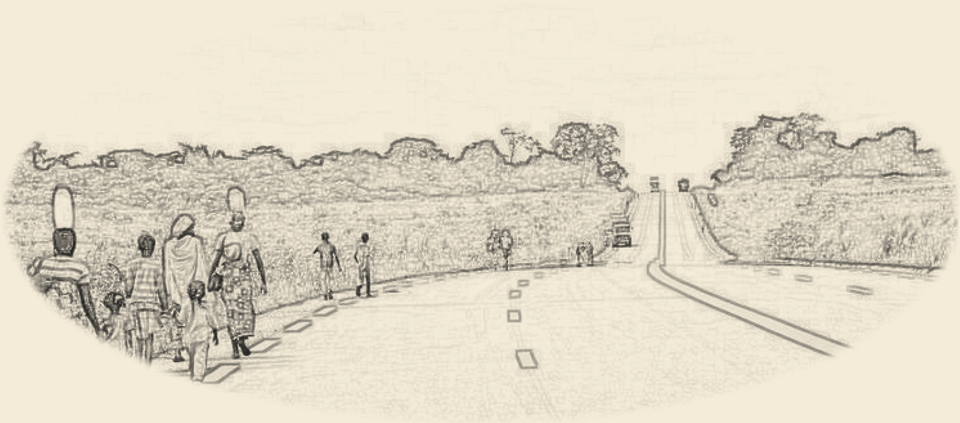
It traverses various landforms – grasslands, river valleys, forests, plateaus and swamps – connecting large and small towns, major economic sectors in the east and west, and 65 percent of the population, bringing tangible benefits to the Congolese, who regard it as a dream road.
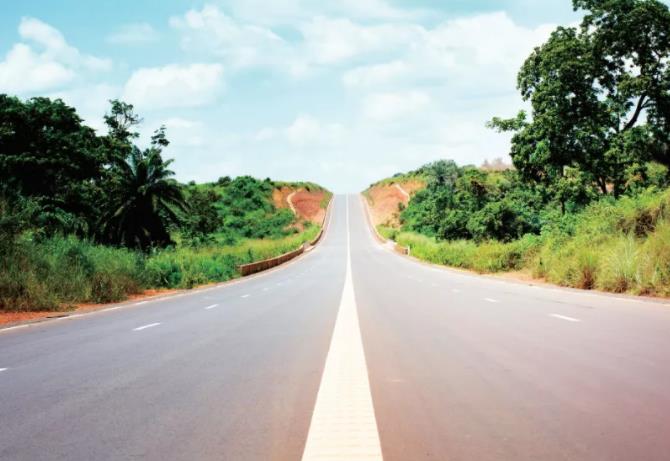
The No. 1 National Highway, the dream road of the Republic of the Congo
Metamorphosis of a Dirt Road
The beautiful Congo River is one of the most important river systems in the African hinterland. It winds its way through the Congo Basin, feeding millions of people, and empties into the Atlantic Ocean. The vast primeval forests, lakes and swamps along the river are rich in oil and minerals and Brazzaville and Pointe-Noire are twin pearls on its lower reaches.
The Congo Basin has a complex topography with dense forests and an equally complex hydrology with numerous river networks, which made land traffic and transportation between Pointe-Noire and Brazzaville difficult though the two cities are only a few hundred kilometers apart. They were connected by a dirt road that was in extremely poor condition, making the journey long and agonizing.
Congolese truck driver Tony has been commuting between the two cities for years. In the past, a one-way trip would take him at least a week. The hardest part of it was not the long hours but the bad road. The dirt road was full of potholes, aggravated by the heavy trucks shuttling back and forth. When it rained, the road would be waterlogged, causing the cars to stall or break down.
Tony can't remember how many times his engine stopped or the truck got stuck in a hole. On one journey, it took him three days to cover just a little over 100 kilometers, less than one third of the total distance. The ordeals always made him wish for a better road.
The dirt road, built in the 1980s, was only a few meters wide due to technical and economic constraints at the time. It was also poorly maintained, and with dense forests and difficult terrain creating obstructions in stretches, the traffic struggled on the road and the drivers prayed for luck each time they traveled on it.
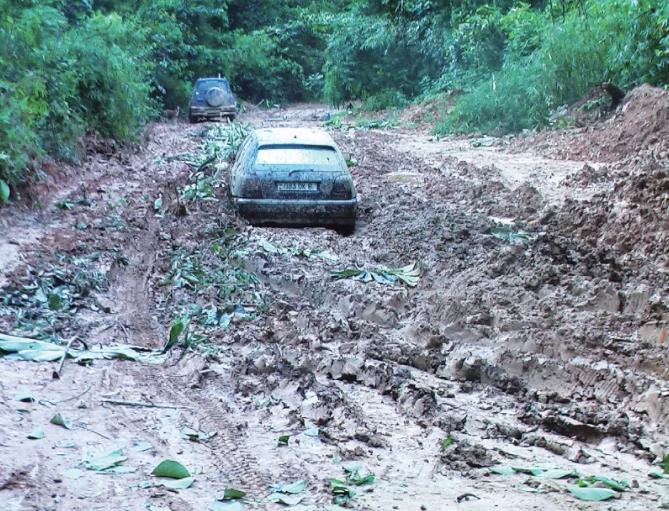
The former dirt road – narrow, obstructed by forests and often muddy
Due to surface transport difficulties, goods between Brazzaville and Pointe-Noire had to be transported either by railway, which was in disrepair and with limited capacity, or by air, which was expensive and had much lower capacity. Both modes had problems and could not meet the transportation demand. The limited transport capacity restricted the flow of people and goods domestically and between the republic and its neighboring countries. Despite its rich resources and the development potential of the people, the Congo could not tap them for economic and social development.
"If you want to get rich, build a road first," goes a Chinese proverb. The economy of the Congo could not take off without convenient transportation. The government had long envisioned building a standard east-west road linking the country's two major cities to address the capacity bottleneck. However, lack of funds and the harsh natural conditions along the way prevented the implementation of the plan.
Ultimately, the mutually-beneficial cooperation between China and Africa that seeks to serve the common interests of the Chinese and Africans turned the dream into reality. Under a cooperation agreement between China and the Congo, the project was finalized and China State Construction Engineering Corporation was given the contract to build the highway. It became the largest infrastructure project in the history of China-Congo cooperation.
The Chinese and Congolese governments and enterprises worked closely from 2008 to 2016 under the frameworks of the Belt and Road Initiative and the Forum on China-Africa Cooperation. Through candid communication and sincere cooperation, they accomplished what was widely believed to be an impossible task.
March 1, 2016 is a milestone in China-Congo cooperation and friendship. On that day, the No. 1 National Highway opened to traffic.
Congolese President Denis Sassou-Nguesso hailed it as a historic achievement, saying the Chinese builders "have fulfilled the dream of generations of Congolese people, and China is sincere in helping us develop our economy."
Great Work, Man!
When construction started, the complex terrain presented a great challenge. The sheer cliffs, the dense forests that often blocked the way, stretches of no-man's land where even the locals dared not venture, proliferation of snakes and insects and the harsh climate – these were among the many enemies that the construction team would have to overcome.
Many foreign companies were skeptical about the project, not believing that a Chinese company would be able to build a standard highway in such harsh conditions.
The difficulties were unimaginable. In the early stage when supplies had not yet arrived, the construction workers had to get drinking water by collecting rainwater from the tropical rainforests in metal buckets, which was a unique experience. They struggled to adapt to the climate and local diet. The sanitation was poor, and mosquitoes were rampant. Almost everyone was bitten by unknown insects, and in serious cases, people went into coma for days. Malaria and typhoid were common. The workers would joke among themselves, saying, "Here you get to experience all the tropical diseases."
"Often we had to camp out in remote areas. On cloudy and starless nights, we couldn't see a thing. We were all city dwellers and the darkness was unnerving," Wei Lerong, a construction worker, said. "Pythons and crocodiles lurked around and sometimes it was dangerous to take even a step without checking the area carefully."
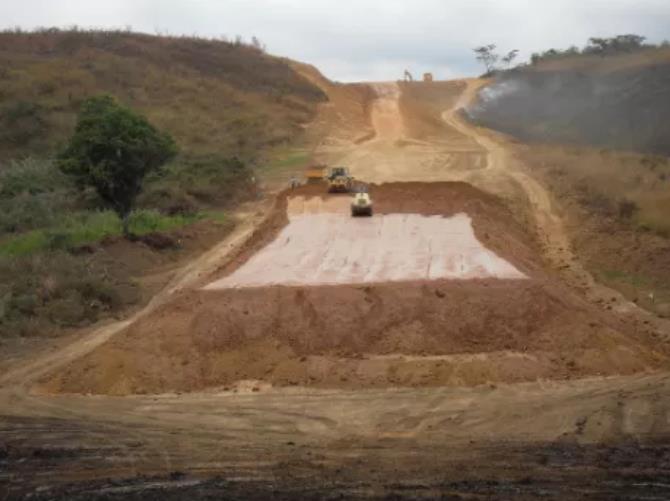
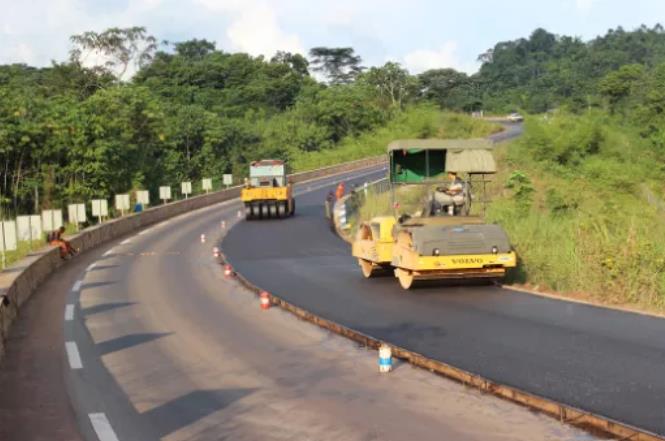
Road rollers at work
Still, they kept building the road defying the harsh conditions. They labored on mountains and waded through rivers with their heavy measuring instruments, searched waist-deep marshes for traverse points, and used excavators as the only available means of transportation when there was no road to go ahead.
During the rainy season, which lasts half a year in the Congo, the heavy rains turn forests into swamps or even fast-flowing rivers. The best construction time is only six months at the most. So the builders worked hard when it was dry, hoping to catch up with the schedule.
The locals often saw bright lights and heard machines roaring at the construction site late at night as the builders often worked all night. Trucks loaded with construction materials and machinery purchased from various places would arrive at the site day and night to ensure progress of the work. The hectic scene showed the construction team was not afraid of any problems.
Though the difficult conditions sometimes led to disruption in supplies, the builders' dedication did not wane and they maintained high standards to ensure project quality. The excellent quality impressed the Congolese Government, the people and foreign enterprises as well.
One of the construction workers, a bearded Chinese called Ma Jianming, looked scruffy but at work strove for perfection in every detail and his work showed the highest construction standards. Once a French supervisor, who was very critical of the construction standards, was inspecting the quality of the roadbed. He found the section in Ma's charge to be very strong despite heavy rain. It made him give Ma a thumbs-up, saying: "Chinois, super!" (Great work, man!) After that, the French supervisor showed absolute faith in the quality of any section that was under Ma.
Later, the French supervisor found that there were more Ma Jianmings working on the project, and his attitude towards Chinese construction quality changed from skepticism to admiration. "Chinese quality" gradually established a reputation among the public.
At the opening ceremony of the second phase of the highway, the Congolese president awarded 14 representatives of all parties involved in the construction the honor of Knight of the Order of Merit, the highest ranking order of the country. The high standards and irreproachable conduct of the builders won praise from the government and the people.
A Better Life
In the southeastern Pool Province, a small village with a population of nearly 400 has experienced a complete change as the new highway transformed the village. In the past, the village struggled to sell its surplus grain in the big cities due to the distance, and consequently the farmers' income was barely enough to live on. The construction of the highway changed the lives of the villagers. During the peak construction period, almost the entire working-age population of the village worked on the project, which greatly increased their overall income.
Philip, 47, the village head, is delighted by the visible changes the highway has made in the lives of the villagers and their minds as well. Now farming is no longer the only livelihood option. The villagers also work as drivers, repairmen and handymen. Even those who did not have any vocational skills are acquiring them and getting new jobs. And the village's agricultural produce can be sent to the big cities fast. The villagers' income has greatly improved and their life is getting increasingly better.
Philip himself is one of them. Since he has a large family, in the past he used to depend on a bountiful harvest to keep his family warm and fed. But the new highway made him realize the importance of acquiring other skills to make a better living and the role of education in changing lives. Going out of the village to acquire new knowledge and skills has become a new objective of the villagers who were once dependent on the weather for their livelihood.
Philip also got a job on the highway, which brought him into daily contact with the Chinese construction crew. At first he was shocked by their hard work, tenacity and pursuit of excellence, and then began to admire these qualities. It also made him develop a keen interest in China and Chinese culture. He hopes that his children can one day go to China to learn advanced technology, work in Chinese companies and change their life. He often tells them, "This highway changed our lives. The Chinese, who built it, are our good friends!"
The No. 1 National Highway has facilitated traffic and reduced the commuting time between Pointe-Noire and Brazzaville from at least one week to eight hours. The traffic volume has increased from around 160 vehicles per day to more than 4,000. The average daily traffic volume has increased by more than 10 times. Most of the Congo's import and export of important materials, minerals and forest resources is done through the highway to Pointe-Noire.
The Congo's Brazza Times wrote in praise of the highway: "Since its opening, it has greatly improved the conditions for the free flow of goods and people, and opened the doors of urban areas and longclosed areas. It has stimulated the development of agriculture and forestry in the provinces along the way, enabling crops and other products to be transported to consumption areas. It has also helped develop tourism, leisure and sightseeing...."
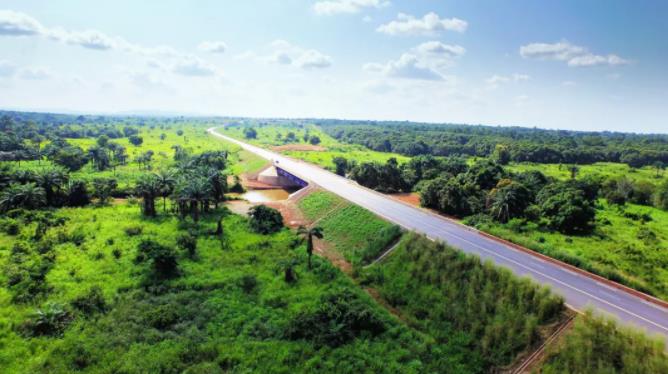
The No. 1 National Highway
China State Construction Engineering Corporation has reached an agreement with the Government of Congo and a French company for the highway's operation, maintenance and overhaul. A road to the future, the No. 1 National Highway will certainly see greater traffic, and is bound to deliver more exciting achievements in the days to come.
FOR MORE
Project Overview
A mutually-beneficial cooperation project between China and Congo, the No. 1 National Highway was constructed by China State Construction Engineering Corporation. Construction started in May 2008 and was completed in March 2016.
The 536-kilometer road starts from Pointe-Noire, the Congo's second largest city, and ends in Brazzaville, the capital. The project provided more than 10,000 local jobs. The wages paid to local workers were at least 8 percent above the national minimum wage in the Congo. The project also provided training for local employees, and nurtured more than 80 local management personnel and over 4,000 technical personnel in the field of engineering, thus bridging the local shortage of engineering talent.


